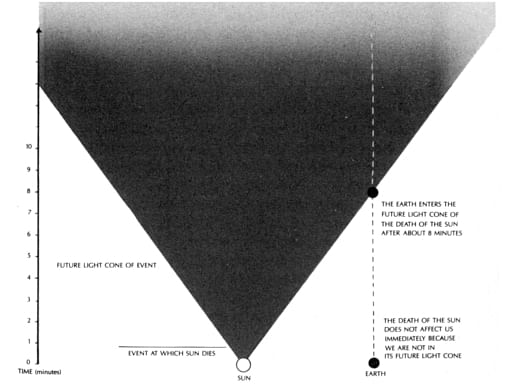
Sep '11 - Nov '11

-=-
We learn at elementary school that the morning sunlight took eight minutes to arrive. Each ray of light from the sun acts as an exiled messenger who indicates whether the star is on or off. When the sun dies, it will take eight minutes for its last message to reach the Earth.
As Stephen Hawking states in A Brief History of Time, ‘the death of the sun does not affect us immediately because we are not in its future light cone‘. Since the fastest way we can perceive distant events is through light, its direction and speed of travel limits how quickly we can experience an event. Mapped through time, the event forms a conical horizon around itself whose width is determined by the speed of light rays; if the observer is within its boundary, we can perceive the event; if outside, there is no way we can know of it. In other words, our universe is structured so that we are always looking at the past.
-=-
Throughout history, light had been the signal that bridges past, present, and future, and brings about the beginning and end of time. According to ancient Hebrew belief, life takes a linear path, beginning with the Genesis Creation myth where God said, “Let there be light!”. In the Judeo-Christian worldview, the eschaton – the end of time – was crucial in establishing the belief that linear time justified a particular system of ethics and law.
In the Myth of the Eternal Return, the mythologist and religious historian Mircea Eliade describes a worldview where the universe is cyclical and is destined to repeat itself in a self-similar form for an infinite number of times across time and space. This worldview was inherent in Indian (and later Egyptian) philosophy, and was later taken up by followers of Pythagoras as well as the Stoics. The cyclical view of time was more in keeping with pre-historical, agrarian communities in which seasons and daily cycles had more significance than the progress of civilization and history.
The linear view of time tends to dominate modern thought, and we obsess over possible environmental and apocalyptic endings to human history. However, some contemporary astrophysicsts, following Einstein, have analyzed the behaviour of light and the nature of space-time as an infinite universe, with implications similar to cyclical views of time and history.
-=-

(left) An event is visible through time, like a pebble thrown into a bond creates outward waves /// (right) An event in the present can only be perceived in a certain region of space-time.
-=-
Knowing that our time in the sun is limited, sometimes we try to capture time and light with images. Albrecht Durer’s etching, “Melancholia I” associates light with order and darkness with chaos. The composition places the products of the imagination – geometry, mathematics, tools, and architecture – within the timeframe of an hourglass running out.
In this picture, the imagination succeeds in creating a mental zone that overrides both astrophysics and religion – it holds together past, present and future with rays of perpetual sunlight – messengers of time etched in metal.

--
/// next week: skin, shell and skeleton part I
/////
No Comments
Block this user
Are you sure you want to block this user and hide all related comments throughout the site?
Archinect
This is your first comment on Archinect. Your comment will be visible once approved.